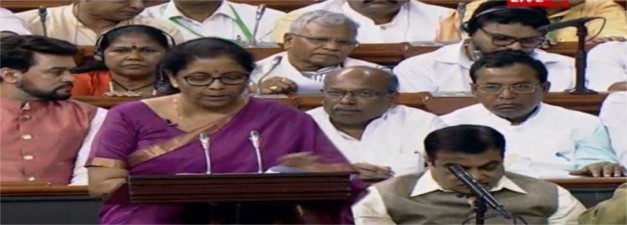
Finance Minister Nirmala Sitharaman on Saturday said due to the weak revenue generation, and poor private capital formation, the government had to take recourse to the 'escape' clause in the FRBM Act and she had pinned all hope on improving GST collections, higher tax compliance after corporate rate cut and increased disinvestment target of Rs 2.1 lakh crore as strong revenue generation sources to help meet 3.5 per cent fiscal deficit in FY 21.
"We had announced 3.3 per cent fiscal deficit in July. Because of low consumption and demand, private investment was not happening at the expected pace as it should have, revenue expenditure had jacked up, GST collection came down.... on the one hand, revenue generation could not be pressed further and on the other there was a very clear demand on public spending, and it was clear that we have to go for spending as we had to ensure that no pending amounts are lying. So it was obvious that without violating the FRBM Act, Awe had to press for the 'escape clause and therefore the fiscal deficit is 3.8 per cent this year.
"But today if we look at revenue generation, in the last three months itself, the GST collection has crossed Rs 1 lakh crore and as time runs, the reduction in the corporate tax and the benefits derived by the Indian companies will all come together in the coming months. So improvement in GST collection and the benefits of corporate tax cuts and companies availing exemptions to get the reduction... I guess revenue generation improvement which will help the fiscal deficit of 3.8 per cent this year to come down to 3.5 per cent in next fiscal," Sitharaman said at the post-Budget press conference.
For the current fiscal, the government has invoked the "escape clause" which allows a 0.5 per cent slippage from the annual target.
"The gross GST revenue collected in the month of January 2020 is Rs 1,10,828 crore of which CGST is Rs 20,944 crore, SGST is Rs 28,224 crore, IGST is Rs 53,013 crore (including Rs 23,481 crore collected on imports) and cess is Rs 8,637 crore (including Rs 824 crore collected on imports)," the government data said.
The estimated gross tax revenue shortfall is Rs 2.2 lakh crore for 2019-20.
When the Modi government came to power in 2014, then Finance Minister Arun Jaitley retained the fiscal deficit target at 4.1 percent as was stated in the interim Budget. In his budget speech for 2015-16, he put out the fiscal consolidation roadmap setting the target at 3.9 per cent for FY16, 3.5 per cent for FY17 and 3 per cent for FY18.
But in the Budget presented in February 2018, the revenue from GST was accounted for just 11 months which meant that the government skipped GST receipts for March. This meant that the Modi government clocked a fiscal deficit target of 3.5 per cent from the Budgeted 3.2 per cent causing a fiscal slippage.
The N.K. Singh committee looked into the FRBM Act in May 2016 and recommended a fiscal glide path for the government that would have gradually brought down the fiscal deficit to 3 per cent of GDP by the end of FY20 and further reduced it to 2.8 per cent by FY21 and 2.5 per cent by FY23. The committee recommended a combined debt-to-GDP of 60 per cent by FY23.
The NK Singh committee also introduced an escape clause in its recommendations allowing the government slippages up to 50 basis points or 0.5 per cent of the GDP in case of extraordinary circumstances. Even though the government has resolutely stuck to its budgetary target of 3.3 per cent, many economists feel that the sops announced like the corporate tax cuts and the tepid GST collections could cast a shadow on government's fiscal roadmap and might lead to redrawing of the fiscal glide path.
Investors and rating agencies closely track government's fiscal deficit targets as a marker of financial discipline.


.jpeg)

